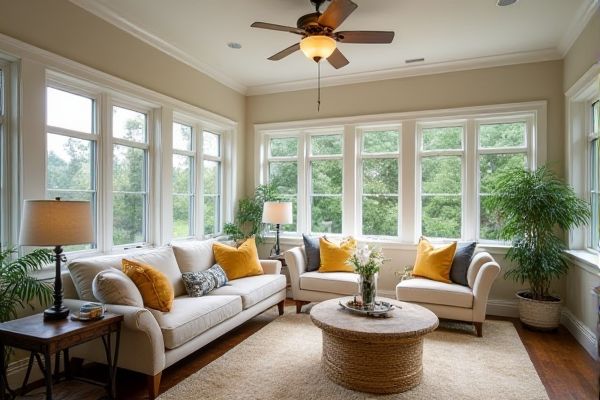
Choosing a ceiling fan for your sunroom can significantly enhance air circulation and comfort by reducing heat buildup during warm days. Discover how installing a ceiling fan compares to having no fan at all and how it impacts your sunroom's climate control in the rest of this article.
Table of Comparison
| Feature | Ceiling Fan | No Fan (Sunroom) |
|---|---|---|
| Air Circulation | Enhances airflow, reduces humidity | Limited airflow, may feel stagnant |
| Temperature Control | Improves comfort by cooling without AC | Relies on natural ventilation or AC |
| Energy Efficiency | Low energy consumption, cost-effective cooling | Potentially higher cooling costs |
| Noise Level | Minimal, white noise effect | Silent, but no airflow sound |
| Installation | Requires electrical wiring and mounting | No installation needed |
| Comfort Level | Increases comfort during warm weather | May become uncomfortable during heat |
| Cost | Initial purchase and installation cost | No cost |
| Maintenance | Periodic cleaning and possible repairs | Minimal |
Introduction: Sunroom Comfort Considerations
Sunroom comfort significantly improves with the installation of a ceiling fan, as it enhances air circulation and reduces indoor humidity levels, creating a more pleasant environment during warm months. Without a fan, sunrooms can become stuffy and overheated due to large window areas and direct sunlight exposure, leading to discomfort and limited usability. Ceiling fans with adjustable speeds and energy-efficient motors optimize energy consumption while maintaining consistent airflow, making them an essential feature for year-round sunroom enjoyment.
The Role of Air Circulation in Sunrooms
Air circulation in sunrooms significantly impacts indoor comfort and energy efficiency by reducing heat buildup and discouraging humidity accumulation. Installing a ceiling fan enhances airflow, helping to distribute cooler air evenly and preventing stagnant zones that can lead to mold or mildew. Your choice to add a ceiling fan supports better ventilation, maintaining a pleasant environment year-round.
Ceiling Fan Benefits for Sunroom Use
Ceiling fans in sunrooms improve air circulation, reducing heat buildup and enhancing comfort during warm weather. They help regulate temperature, making your sunroom usable year-round by preventing stuffiness and promoting ventilation. Installing a ceiling fan also contributes to energy efficiency by allowing you to rely less on air conditioning.
Temperature Regulation: Fan vs. No Fan
A ceiling fan in your sunroom significantly improves temperature regulation by promoting air circulation, reducing heat buildup during hot days, and providing a cooling breeze without lowering the room's temperature. Without a fan, stagnant air leads to increased heat retention and discomfort, especially in enclosed sunrooms with extensive glass exposure. Installing a ceiling fan helps maintain a more consistent and comfortable temperature, making your sunroom usable even during warmer weather.
Energy Efficiency and Utility Costs
Installing a ceiling fan in your sunroom significantly enhances air circulation, reducing reliance on air conditioning and lowering energy consumption. This improved ventilation can decrease utility costs by maintaining a more consistent temperature and minimizing the need for electric cooling. Choosing a high-efficiency ceiling fan with an ENERGY STAR rating ensures optimal performance while maximizing energy savings in your sunroom.
Humidity Control and Air Freshness
Ceiling fans in a sunroom significantly enhance humidity control by promoting better air circulation, which helps reduce moisture buildup and prevents mold growth. Without a fan, stagnant air can lead to increased humidity levels, making the space feel damp and uncomfortable. Your sunroom will stay fresher and more inviting with a ceiling fan circulating air efficiently throughout the area.
Aesthetic Impact: Visual Appeal of Ceiling Fans
Ceiling fans in a sunroom enhance visual appeal by adding dynamic architectural detail and complementing various interior styles, from rustic to modern. Their design options, ranging from sleek minimalistic blades to ornate vintage finishes, create a focal point that elevates the room's ambiance. Without a fan, a sunroom may appear more open but can lack the layered texture and visual interest that ceiling fans provide in terms of shape, material, and movement.
Noise Levels and Peace in Sunrooms
Ceiling fans in sunrooms generate noise levels typically ranging from 20 to 50 decibels, which can create a gentle ambient sound that masks outdoor noise and promotes relaxation. In contrast, no fan setups maintain complete silence, preserving maximum peace for activities like reading or meditation. Selecting a fan with low-decibel ratings ensures enhanced tranquility without compromising air circulation in sunrooms.
Installation and Maintenance Factors
Installing a ceiling fan in your sunroom requires consideration of wiring access, ceiling height, and structural support to ensure proper balance and safety. Maintenance involves regular cleaning of blades to prevent dust buildup and occasional motor lubrication, which can extend the fan's lifespan and improve efficiency. In contrast, a sunroom without a fan eliminates installation hassle and maintenance tasks but may rely more heavily on alternative cooling solutions or natural ventilation.
Final Verdict: Choosing the Right Option for Your Sunroom
Ceiling fans improve air circulation in sunrooms, reducing heat buildup and enhancing comfort during warm months. Without a fan, sunrooms may become stagnant and uncomfortably warm, especially under direct sunlight. Choosing a ceiling fan is ideal for maintaining airflow, temperature regulation, and increasing energy efficiency in sunroom spaces.
 homyna.com
homyna.com